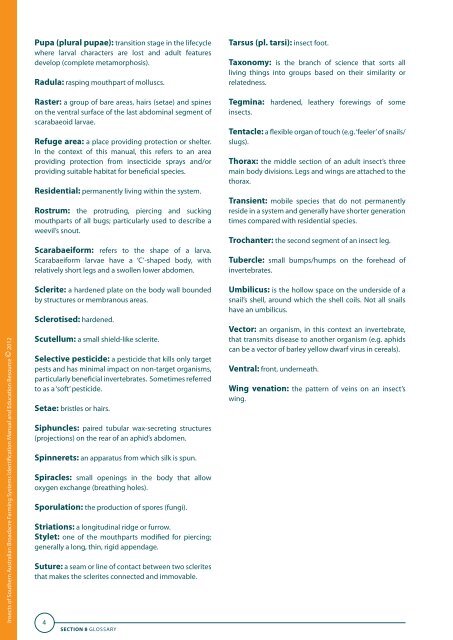Insects of Southern Australian Broadacre Farming Systems - Grains ...
Insects of Southern Australian Broadacre Farming Systems - Grains ...
Insects of Southern Australian Broadacre Farming Systems - Grains ...
Create successful ePaper yourself
Turn your PDF publications into a flip-book with our unique Google optimized e-Paper software.
<strong>Insects</strong> <strong>of</strong> <strong>Southern</strong> <strong>Australian</strong> <strong>Broadacre</strong> <strong>Farming</strong> <strong>Systems</strong> Identification Manual and Education Resource © 2012<br />
Pupa (plural pupae): transition stage in the lifecycle<br />
where larval characters are lost and adult features<br />
develop (complete metamorphosis).<br />
Radula: rasping mouthpart <strong>of</strong> molluscs.<br />
Raster: a group <strong>of</strong> bare areas, hairs (setae) and spines<br />
on the ventral surface <strong>of</strong> the last abdominal segment <strong>of</strong><br />
scarabaeoid larvae.<br />
Refuge area: a place providing protection or shelter.<br />
In the context <strong>of</strong> this manual, this refers to an area<br />
providing protection from insecticide sprays and/or<br />
providing suitable habitat for beneficial species.<br />
Residential: permanently living within the system.<br />
Rostrum: the protruding, piercing and sucking<br />
mouthparts <strong>of</strong> all bugs; particularly used to describe a<br />
weevil’s snout.<br />
Scarabaeiform: refers to the shape <strong>of</strong> a larva.<br />
Scarabaeiform larvae have a ‘C’-shaped body, with<br />
relatively short legs and a swollen lower abdomen.<br />
Sclerite: a hardened plate on the body wall bounded<br />
by structures or membranous areas.<br />
Sclerotised: hardened.<br />
Scutellum: a small shield-like sclerite.<br />
Selective pesticide: a pesticide that kills only target<br />
pests and has minimal impact on non-target organisms,<br />
particularly beneficial invertebrates. Sometimes referred<br />
to as a ‘s<strong>of</strong>t’ pesticide.<br />
Setae: bristles or hairs.<br />
Siphuncles: paired tubular wax-secreting structures<br />
(projections) on the rear <strong>of</strong> an aphid’s abdomen.<br />
Spinnerets: an apparatus from which silk is spun.<br />
Spiracles: small openings in the body that allow<br />
oxygen exchange (breathing holes).<br />
Sporulation: the production <strong>of</strong> spores (fungi).<br />
Striations: a longitudinal ridge or furrow.<br />
Stylet: one <strong>of</strong> the mouthparts modified for piercing;<br />
generally a long, thin, rigid appendage.<br />
Suture: a seam or line <strong>of</strong> contact between two sclerites<br />
that makes the sclerites connected and immovable.<br />
4<br />
SECTION 8 GLOSSARY<br />
Tarsus (pl. tarsi): insect foot.<br />
Taxonomy: is the branch <strong>of</strong> science that sorts all<br />
living things into groups based on their similarity or<br />
relatedness.<br />
Tegmina: hardened, leathery forewings <strong>of</strong> some<br />
insects.<br />
Tentacle: a flexible organ <strong>of</strong> touch (e.g. ‘feeler’ <strong>of</strong> snails/<br />
slugs).<br />
Thorax: the middle section <strong>of</strong> an adult insect’s three<br />
main body divisions. Legs and wings are attached to the<br />
thorax.<br />
Transient: mobile species that do not permanently<br />
reside in a system and generally have shorter generation<br />
times compared with residential species.<br />
Trochanter: the second segment <strong>of</strong> an insect leg.<br />
Tubercle: small bumps/humps on the forehead <strong>of</strong><br />
invertebrates.<br />
Umbilicus: is the hollow space on the underside <strong>of</strong> a<br />
snail’s shell, around which the shell coils. Not all snails<br />
have an umbilicus.<br />
Vector: an organism, in this context an invertebrate,<br />
that transmits disease to another organism (e.g. aphids<br />
can be a vector <strong>of</strong> barley yellow dwarf virus in cereals).<br />
Ventral: front, underneath.<br />
Wing venation: the pattern <strong>of</strong> veins on an insect’s<br />
wing.

















